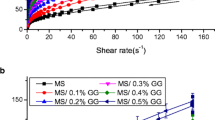Abstract
In this research, rheological properties of blends of pine honey (3%, 6%, and 9%) with sesame pastes (tahin) produced from hulled roasted sesame seeds, called simply tahin, and from unhulled roasted sesame seeds, so-called Bozkir tahin, were determined at temperatures ranging from 10°C to 60°C and at speeds ranging from 0.5 to 100 rpm. Tahin and Bozkir tahin blends with pine honey were found to exhibit non-Newtonian, pseudoplastic behavior at all temperatures. Apparent viscosities versus speed data were successfully fitted to the power law model. The flow behavior index, n, varied in the range of 0.4226–0.6228 for the tahin–pine honey blends, and in the range of 0.4661 to −0.7266 for the Bozkir tahin–pine honey blends. The consistency index, K, was in the range of 9.34–36.42 Pa·sn for tahin–honey blends, and in the range of 9.92–37.53 Pa·sn for Bozkir tahin–honey blends. The consistency index (K) increased with increasing honey levels in both tahin types. According to statistical analysis, the exponential model was a better model to describe the effect of the soluble solids on the viscosity of tahin samples represented by the pine honey percentage. The emulsion stability of both tahin types improved with the addition of pine honey. It was also correlated with activation energy (E a), Arrhenius constant, some sensory properties such as spreadibility, firmness and overall acceptance, and color parameters such as the C and h. Temperature sensitivity of the consistency index was assessed by applying an Arrhenius type equation, and E a value appeared in the range of 7.61–10.05 kJ/mol for tahin–honey blends and in the range of 9.02–10.50 kJ/mol for Bozkir tahin–honey blends.



Similar content being viewed by others
References
Akbulut, M. (2008). Comparative studies of mineral contents of hulled sesame paste (tahin), unhulled sesame paste (bozkir tahin) and their blends. Asian Journal of Chemistry, 20(3), 1801–1805.
Akbulut, M., & Coklar, H. (2008). Physicochemical and rheological properties of sesame pastes (tahin) processed from hulled and unhulled roasted sesame seeds and their blends at various levels. Journal of Food Process Engineering, 31, 488–502.
Akbulut, M., Coklar, H., & Ozen, G. (2008). Rheological characteristics of Juniperus drupacea fruit juice (pekmez) concentrated by boiling. Food Science and Technology International, 14(4), 321–328.
Akbulut, M., & Ozcan, M. M. (2008). Some physical, chemical, and rheological properties of sweet sorghum (Sorghum bicolor (L) moench) pekmez (molasses). International Journal of Food Properties, 11, 79–91.
Akbulut, M., Ozcan, M. M., & Coklar, H. (2009). Evaluation of antioxidant activity, phenolic, mineral contents and some physicochemical properties of several pine honeys collected from Western Anatolia. International Journal of Food Sciences and Nutrition, 60(7), 577–589.
Alpaslan, M., & Hayta, M. (2002). Rheological and sensory properties of pekmez (grape molasses)/tahin (sesame paste) blends. Journal of Food Engineering, 54(1), 89–93.
Arslan, E., Yener, M. E., & Esin, A. (2005). Rheological characteristics of tahin/pekmez (sesame paste/concentrated grape juice) blends. Journal of Food Engineering, 69, 167–172.
Bhattacharya, S., Bhat, K. K., & Raghuver, K. G. (1992). Rheology of Bengal gram Cicer arietinum flour suspensions. Journal of Food Engineering, 17, 83–96.
Cheftel, J. C., Cuq, J. L., & Lorient, D. (1985). Amino acids, peptides and proteins. In O. R. Fennema (Ed.), Food chemistry (pp. 245–369). New York: Marcel Dekker.
Chinnan, M. S., McWaters, K. H., & Rao, V. N. M. (1985). Rheological characterization of garin legume pastes and effect of hydration time and water level on apparent viscosity. Journal of Food Science, 50, 1167–1171.
Dickinson, E. (1992). An Introduction to Food Colloids. Oxford: Oxford University Press.
Emadzadeh, B., Razavi, S. M. A. & Mahallati, M. N. (2011). Effect of fat replacers and sweeteners on the time-dependent rheological characteristics and emulsion stability of low calorie pistachio butter: A response surface methodology. Food and Bioprocess Technology, doi:10.1007/s11947-010-0490-6.
Hill, M. A., Mitchell, J. R., & Sherman, P. A. (1995). The relationship between the rheological and sensory properties of a lemon pie filling. Journal of Texture Studies, 26(4), 457–470.
Jing, H., Yap, M., Wong, P. Y. Y., & Kitts, D. D. (2009). Comparison of physicochemical and antioxidant properties of egg-white proteins and fructose and inulin Maillard reaction products. Food and Bioprocess Technology, doi:10.1007/s11947-009-0279-7.
Kokini, J. L., & Dickie, R. (1982). A model of food spredability from fluid mechanics. Journal of Texture Studies, 13, 211–227.
Maskan, M., & Göğüş, F. (2000). Effect of sugar on the rheological properties of sunflower oil-water emulsion. Journal of Food Engineering, 43, 173–177.
McClements, D. J. (1999). Food Emulsions: Principles, Practice and Techniques. Boca Raton: CRC.
McClements, D. J. (2003). The rheology of emulsion-based food products. In B. M. McKenna (Ed.), Texture in Food: Semi-solid Foods (pp. 3–15). New York: CRC.
McClements, D. J. (2005). Food Emulsions: Principles, Practices, and Techniques. Boca Raton: CRC.
Prinyawiwatkul, W., Beuchat, L. R., & McWatters, K. H. (1993). Functional property changes in partially defatted peanut flour caused by fungal fermentation and heat treatment. Journal of Food Science, 58, 1318–1323.
Rao, M. A. (1999). Rheology of Fluid and Semisolid Foods: Principles and Applications. Gaithersburg: Aspen.
Sato, T., & Miyata, G. (2000). The nutraceutical benefit, part II: Honey. Nutrition, 16, 468–469.
Singh, S. K., Castell-Perez, M. E., & Moreira, R. G. (2000). Viscosity and textural attributes of reduced-fat peanut pastes. Journal of Food Science, 65, 849–853.
Weiss, J., Coupland, J. N., & McClements, D. J. (1996). Solubilization on hydrocarbon emulsion droplets suspended in nonionic surfactant micelle solutions. Journal of Physical Chemistry, 100, 1066–1071.
Weiss, J., & Liao, W. (2000). Addition of sugars influences color of oil-in-water emulsion. Journal of Agricultural and Food Chemistry, 48, 5053–5060.
Wendin, K., & Hall, G. (2001). Influences of fat, thickener and emulsifier contents on salad dressing: static and dynamic sensory and rheological analyses. LWT- Food Science and Technology, 34, 222–233.
Author information
Authors and Affiliations
Corresponding author
Rights and permissions
About this article
Cite this article
Akbulut, M., Saricoban, C. & Ozcan, M.M. Determination of Rheological Behavior, Emulsion Stability, Color, and Sensory of Sesame Pastes (Tahin) Blended with Pine Honey. Food Bioprocess Technol 5, 1832–1839 (2012). https://doi.org/10.1007/s11947-011-0668-6
Received:
Accepted:
Published:
Issue Date:
DOI: https://doi.org/10.1007/s11947-011-0668-6




